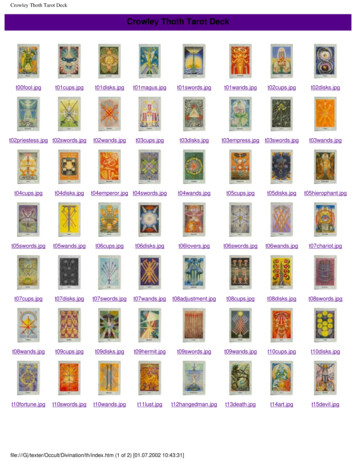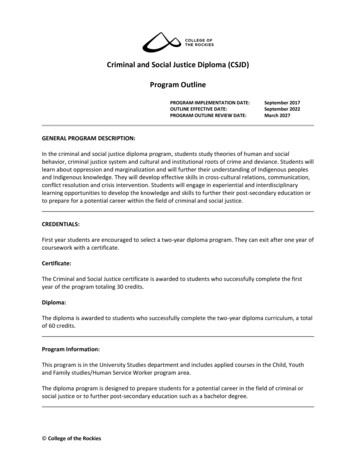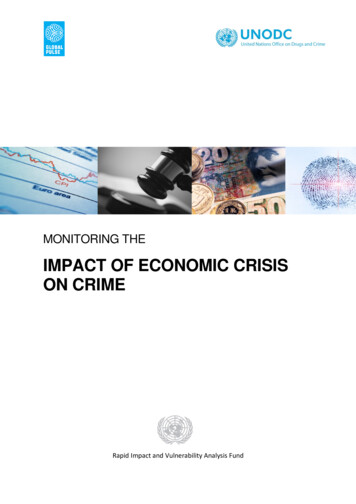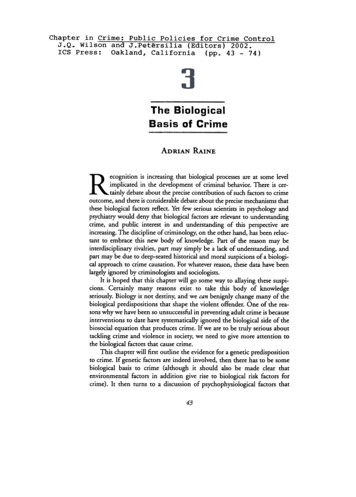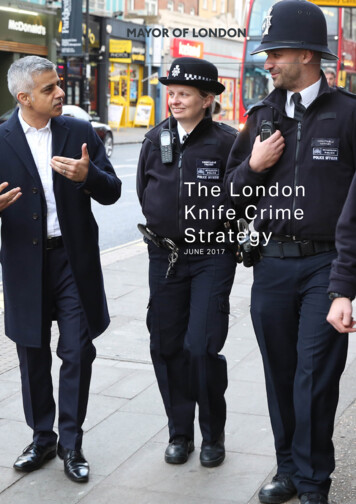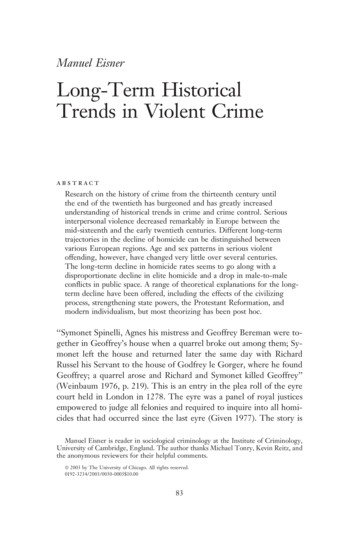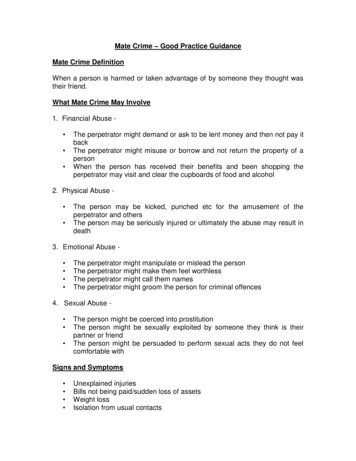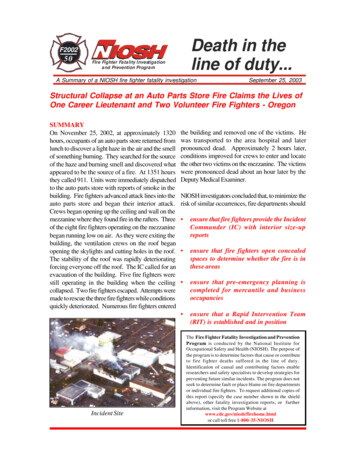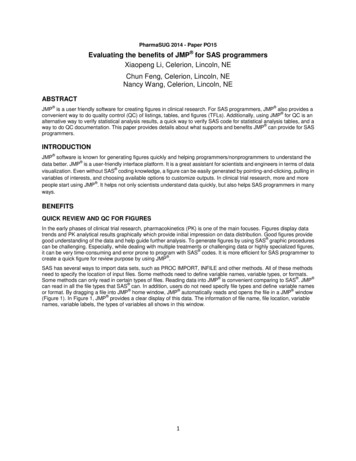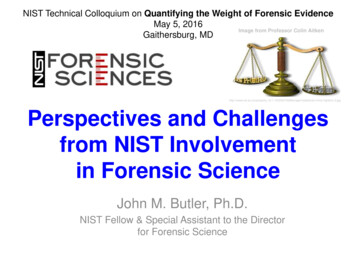
Transcription
NIST Technical Colloquium on Quantifying the Weight of Forensic EvidenceMay 5, 2016Image from Professor Colin AitkenGaithersburg, MDhttp://www.ed.ac.uk/polopoly s-2.jpgPerspectives and Challengesfrom NIST Involvementin Forensic ScienceJohn M. Butler, Ph.D.NIST Fellow & Special Assistant to the Directorfor Forensic Science
Topics to Cover NIST involvement in forensic scienceEarly forensic history of NBS/NISTChallenges faced & some urban legendsDNA challengesThoughts on potential improvementsLessons from history
Standard NIST DisclaimerPoints of view are mine and do not necessarilyrepresent the official position or policies of the USDepartment of Justice or the National Institute ofStandards and Technology.Certain commercial equipment, instruments andmaterials are identified in order to specifyexperimental procedures as completely aspossible. In no case does such identification imply arecommendation or endorsement by the NationalInstitute of Standards and Technology nor does itimply that any of the materials, instruments orequipment identified are necessarily the bestavailable for the purpose.
Acknowledgments and DisclaimersI will quote from my recent book entitled “Advanced Topics in ForensicDNA Typing: Interpretation” (Elsevier, 2015). I do not receive anyroyalties for this book. Completing this book was part of my job at NIST.I have been fortunate to have had discussions withnumerous scientists on DNA interpretation issuesincluding Mike Coble, Bruce Heidebrecht, RobinCotton, Charlotte Word, Catherine Grgicak, Todd Bille,Peter Gill, Ian Evett, John Buckleton Thanks to those who provided input on the Urban Legendideas: Reva Schwartz, Elham Tabassi, Robert Thompson, SusanBallou, Melissa Taylor, Souder research: Kristen Frederick-Frost and Robert Thompson
My Background influences my perspective I developed an early interest in forensic science and researchbefore the CSI TV shows!– Largely from enjoyment of puzzle solving (e.g., Rubik’s cube) and readingSherlock Holmes; took four years of biology in high school Did my PhD research (UVA analytical chemistry degree) at theFBI Laboratory’s Forensic Science Research Unit (1993-1995)– Pioneered modern forensic DNA testing with short tandem repeat (STR)markers and capillary electrophoresis (CE) Came to NIST as an NRC postdoc in 1995, left to work in aSilicon Valley biotech startup in 1997, and returned to NIST in1999 to lead the forensic DNA team (now the Applied Genetics Group)– Developed the STRBase website and have written five textbooks on forensicDNA typing and 150 articles (primarily on methodology issues);interpretation of evidence has became a recent passion (2010 topresent) largely from what I learned in writing my last two books In April 2013, I left the NIST lab and moved to the Special ProgramOffice to help with the overall NIST efforts in forensic science– My interests now range well beyond just DNA
NIST Involvementin Forensic ScienceWhy?
Why is NIST involved in forensic science? Our assistance and technical expertise wasrequested by DOJ and nt of FBI Laboratory (early 1930s)Automated fingerprint detection (1960s to present)Law Enforcement Standards Laboratory (established in 1971)“Starch Wars” (1977 to 1978)Input on TWGDAM/SWGDAM (1988 to present)DNA reference materials (early 1990s to present)FBI’s DNA Advisory Board (1995 to 2000)Digital forensics (late 1990s to present)National Institute of Justice (NIJ) funding (1970s to present)White House Subcommittee on Forensic Science (2009-2012)MOU leading to NCFS and OSAC (2013-present)
The “Starch Wars” Led to NBS/NISTInvolvement in Forensic DNA EffortsForensic Science Review(Jan 2006) 18(1): 59-72 Dennis Reeder (NBS protein gelscientist) asked to investigate 10 years later asked by FBI to be partof TWGDAM (then 17 years later partof DNA Advisory Board)DNA reference material work started Dennis meets John M. Butler at aTWGDAM meeting at the FBIAcademy and hires JMB (twice)AbstractJust as the movie Star Wars had a prequel, so did the "DNA Wars"-the series of legal, scientific, and personal battlesthat took place over the admissibility of forensic DNA evidence from 1989 to 1994. Between the late 1970s and theMark Stolorow,whocame totechniqueNIST in2008miredfromindustry electrophoresis-basedand now leads themid-1980s,another forensicidentificationbecamein controversy:bloodproteinanalysis.Althoughthe Office,debates overbloodanalysiswereevery bit as rancorousfrustrating to almostNISTOSACAffairswasoneof thedevelopersof the andMulti-Systemeverybody- so muchthat theybecame inknownas the"StarchWars" battles - their importance has not beenalmostinvolved40 yearsagosoandinvolvedthoseearlycourtadequately appreciated in the recent history of forensic science. After reviewing the early history of blood typing, Iwill describe the development of the Multi-System approach to blood protein analysis that took place inCalifornia from 1977 to 1978. I will then elucidate the history of the Starch Wars, and demonstrate the ways thatthey shaped subsequent disputes over DNA evidence, especially in California. I will show that: (a) many of theforensic scientists, law enforcement officials, and lawyers who became prominent players in the DNA Warswere deeply involved in the court cases involving protein electrophoresis; and (b) many of the issues thatbecame controversial in the disputes over DNA evidence first emerged in the Starch Wars. In the conclusion, I willsuggest various ways to improve the quality of forensic science based on my analysis of the Starch Wars.
DNA Identification Act (1994)Public Law 103-32242 § 14131. Quality assurance and proficiency testing standards(a)Publication of quality assurance and proficiency testing standards(1) (A) Not later than 180 days after September 13, 1994, the Director of theFederal Bureau of Investigation shall appoint an advisory board on DNA qualityassurance methods from among nominations proposed by the head of theNational Academy of Sciences and professional societies of crime laboratoryofficials.(B) The advisory board shall include as members scientists from State, local,and private forensic laboratories, molecular geneticists and populationgeneticists not affiliated with a forensic laboratory, and a representative fromthe National Institute of Standards and Technology.(C) The advisory board shall develop, and if appropriate, periodicallyrevise, recommended standards for quality assurance, including standardsfor testing the proficiency of forensic laboratories, and forensic analysts, inconducting analyses of DNA.DNA Advisory Board (DAB)
DNA Advisory Board (DAB) Members Joshua Lederberg (Rockefeller University) – chair 1995-1998Arthur Eisenberg (University of North Texas Health Science Center) – chair 1998-2000John Hicks (Alabama Department of Forensic Sciences)Shirley Abrahamson (Wisconsin State Supreme Court)Ranajit Chakraborty (University of Texas Health Science Center)Bruce Budowle (FBI Laboratory)Larry Presley (FBI Laboratory)Existed from 1995-2000Jack Ballantyne (Suffolk County Crime Lab)Jay Miller (FBI Laboratory) Dennis Reeder (National Institute of Standards and Technology) Margaret Kuo (Orange County Sheriff’s Office)Bernard Devlin (Carnegie Mellon University)Marcia Eisenberg (Laboratory Corporation of America)Paul Ferrara (Virginia Division of Forensic Science)Terry Laber (Minnesota State DNA Lab)Dwight Adams, Randall Murch, Barry Brown (FBI Laboratory)David Coffman (Florida Department of Law Enforcement)Fred Bieber (Harvard Medical School)Mary Gibbons (Oakland Police Department)Eric Juengst (Case Western Reserve University)Susan Narveson (Phoenix Police Department)Mohammad Tahir (Indianapolis-Marion County Crime Lab)Dawn Herkenham (FBI Laboratory)This group gave birth tothe FBI Quality AssuranceStandards (QAS) that arenow maintained bySWGDAM (ScientificWorking Group on DNAAnalysis Methods)
U.S. Department of CommerceCo-lead with DOJNationalCommissionon ForensicScienceNIST Point-ofContact (POC):John ButlerA federal advisorycommittee for the U.S.Department of Justicehttp://www.justice.gov/ncfsOrganizationof ScientificAreaCommitteesPOC: Mark Stolorow& John Paul JonesNIST-administered effortdedicated to identifying anddeveloping technicallysound, consensus-baseddocumentary standardsand orensicScienceResearchProgramPOC: Sue BallouSIX FOCUS AREAS1. Ballistics and AssociatedTool Marks2. Digital and IdentificationForensics3. Forensic Genetics4. Toxins5. Trace6. Statisticshttp://www.nist.gov/forensics
Other Recent Meetings NIST and PartnersHave Convened on Forensic Science Topics1.2.3.4.5.6.7.8.9.10.11.12.13.Forensic firearms analysis (July 2012)DNA mixture interpretation training (Apr 2013)Emerging synthetic drugs (May 2013)Forensic handwriting (June 2013)DNA Technical Leader Summit (Nov 2013)Cloud computing forensics (Mar 2014)DNA probabilistic genotyping – Part 1 (May 2014)Mobile forensics (June 2014)DNA validation concepts & resources (Aug 2014)DNA probabilistic genotyping – Part 2 (Sept 2014)Research biometric datasets (Jan 2015)Forensic optical topography (Mar 2015)Quantifying weight of evidence (May 2016) OSAC Public Meetings(Feb 2015 and Feb 2016) Forensics@NIST 2010(NIJ program managers only) Forensics@NIST 2012Forensics@NIST 2014Forensics@NIST 2016(Nov 8-9, 2016)Webcasting and videoarchives exist for mostof these meetingshttp://www.nist.gov/forensics/conferences and events.cfm
Early History ofNBS/NIST Involvementin Forensic ScienceWilmer Souder’s work
Dr. Wilmer Souder and the National Bureau ofStandards Identification Laboratory (1935)Photo taken April 11, 1935(rediscovered August 5, 2015 withinNational Archives NBS collections)
AAFS 2016 PresentationJune 10, 2016a NIST colloquiumpresentation willbe given onSouder and aNIST museumexhibit opened byhis granddaughterSlides available on the NIST STRBase website:http://www.cstl.nist.gov/strbase/pub pres/Souder-AAFS2016-LWS-FINAL.pdf
Reader’s Digest July 1951 articlepp. 118-120
Rediscovery of Wilmer Souder’s NotebooksTransferred to NIST Archives in 2003by Alcohol, Tobacco, Firearms, and Explosives LaboratoryDetailed analysis started in May 2015
Content of Souder Notebook Entries Date for Evidence SubmissionNBS Test NumberSubmitting AgencySubmitting AgentSummary of FindingsDisposition of evidence (chain-of-custody)Case court outcome if knownNewspaper Clippings from casesNBS: National Bureau of Standards (name changed to NIST in 1988)
Number of Cases Worked by Wilmer Souderbased on entries in his notebooksLindberg baby kidnappingransom note evaluations(May 9, 1932 & Jan 16, 1935)807570838 cases74over 25 years655760504555494842During World War 2, Souder wasSecurity Officer for the National Bureauof Standards. From 1946-1950, he wasNBS Metrology Division Chief withheavy administrative responsibilities.He retired in early 1954 at age 70.44424740302420102413719 19451946194719481949195019511952195301713 14FBI Laboratorybegins operation(Nov 24, 1932)# ballisticsTotal Cases
Submitting Agencies(Handwriting, Typewriting, and Ballistics Casework)Total Number of Cases Submitted (1929-1953)350 70% of total cases (592 of 838)from these six agencies30025029220015010050947954JusticePost OfficeInterior0Treasury3736Met. Police US Atty DCDCRemaining 30% of cases were from 75 additional agencies including:Census BureauCivil ServiceDepartment of AgricultureDepartment of CommerceHouse of RepresentativesLibrary of CongressSenate Judiciary CommitteeState DepartmentDC Health DepartmentDC Office of Weights & MeasuresDC Supreme CourtNational Labor Relations BoardNew York Police DepartmentOffice of Civil DefensePatent OfficeSecurity & Exchange CommissionBureau of PrisonsFederal Housing Admin.Federal Trade CommissionGeneral Accounting OfficeGovernment Printing OfficeMilitary Intelligence DivisionUS Secret ServiceWar Department
Early NBS/NIST – FBI ConnectionStudied chemistry at theUniversity of Chicagoand graduated in 1917Charles’ older brotherWilmer Souder, on leave from NBS, receiveda PhD in physics at the University of Chicagoand graduated in 1916 but stayed to teachcourses in physics and chemistry until 1917William D. AppelFirst employee of FBI Technical Laboratory(NBS: 1922-1959)Charles A. Appel, Jr.(FBI: 1924-1948)1942 photo of Special Agent Charles Appel (courtesy of his son Ed Appel)
Conducting Casework in the Background A page from one of Wilmer Souder’snotebooks (rediscovered June 2015)Typewriting caseworkreceived from theDepartment of Justice –Charles Appel (first FBILaboratory employee)on October 28, 1933(10-28-33)All [material returned] toAppel on October 30,1933 (10-30-33)Convicted on Appel’stestimony
FBI Laboratory Began OperationsNovember 24, 1932 with Assistance of Dr. Wilmer SouderPage 47: “The development of the [FBI] Laboratory has beencarefully planned by the Division with the assistance and adviceof Dr. Wilmer Souder, a well-known and recognized authority in thefield of scientific endeavor. Dr. Souder, who is at present acting in anadvisory capacity in the further development of the Laboratory, hasbeen engaged as a scientist by the Bureau of Standards for a periodof eighteen years and has devoted the principle portion of his time tohandwriting, typewriting and ballistics identification. His advice andexperience have rendered invaluable service to the Division inthe training of the Laboratory personnel and in obtainingequipment which is considered the most desirable and essentialfor the performance of its work.”From “A Digest of the Early History of the FBI Laboratory” (prepared by Fred M. MillerJanuary 1956 for use by Don Whitehead in writing Chapter 16 of his 1956 book TheFBI Story); a copy provided to NIST by FBI Historian John Fox on July 9, 2015
Challenges Facedin Forensic Science and some Urban Legends
Slide presented in September 2013 to a White House-led Federal Working Group on Forensic ResearchSome Significant Needs in Forensic ScienceMore critical thinking is needed in forensic scienceat the bench level and in managementProblemNeeds and NIST EffortsMore advanced methods forDNA mixture interpretationDNA Technical Leader Summit(planned for Nov 2013)Growth in mobile &computer forensic needsContinue work to collectcomprehensive software setKeeping up with emergingsynthetic drugsReference materials, massspectral libraries, IR spectrapredictionQuantitative fingerprintevaluationsLarge data sets needed forfingerprints and other patternmatching disciplines to train newmatching algorithms
Important Observations The National Research Council 2009 (“NAS Report”)called for changes to strengthen forensic science (with 13recommendations) but these are not really new issues The criminal justice system, where forensic science onlyplays a small part, is not perfect; there have beenindividuals wrongly convicted for a variety of reasons Despite a few well-publicized examples (e.g., AnnieDookhan), forensic scientists generally want to do a goodjob and are trying to do their best Many forces are at play to either change things or tomaintain the status quo which changes are needed?
Culture Clash: Science and LawTension exists between science and the law: The legal community looks to the past(precedence is desired) The scientific community looks to the future(evolving improvement is desired)Law“Forensic”Science“Science”
Culture Clash: Science and LawTension exists between science and the law: The legal community wants finality andabsolutes (guilty or not-guilty court decisions) The scientific community operates withoutcertainty (rarely with probabilities of 0 or 1)Law“Forensic”Science“Science”
Nomenclature Challenges We often talk past each other (scientists andlawyers or scientists and scientists) becausewe do not appreciate a subtle or significantdifference in the meaning of a word or phrase Examples: “validity” or “validation” can meansomething very different to lawyers than toscientists and forensic practitioners “A reasonable degree of scientific certainty ”(a legal crutch that has no scientific meaning)
Different Statistical Approaches ExistBayesian approachCombines LR with prior odds (or prior probability)Bayes’ TheoremLikelihood Ratio(LR)Pr(E H1 )Prior Odds Posterior OddsPr(E H 2 )Frequentist approachConsiders only a single hypothesis (e.g., Pr(E H2) profileprobability) or the LR involving two mutually exclusive hypothesesFigure 9.2 from J.M. Butler (2015) Advanced Topics in Forensic DNA: Interpretation (Elsevier Academic Press: San Diego)
Data Quality Issues Forensic samples often involve working with apartial data pattern– In DNA, not doing the entire genome and sometimesnot even the entire attempted profile– In latent prints, typically not looking at the entire print A theoretical model may not fit casework data – George Box: “All models are wrong – but some areuseful”
tent/lord kelvin/lord-kelvin.jpgWilliam Thomson, 1st Baron Kelvin, akaLord Kelvin “When you can measure what youare speaking about, and express itin numbers, you know somethingabout it, when you cannot express itin numbers, your knowledge is of ameager and unsatisfactory kind; it maybe the beginning of knowledge, butyou have scarcely, in your thoughtsadvanced to the stage of science.” "There cannot be a greater mistake thanthat of looking superciliously uponpractical applications of science. The lifeand soul of science is its practicalapplication." [PLA, vol. 1, "ElectricalUnits of Measurement", May 3, 1883]Slide courtesy of Rich Cavanagh (NIST Special Programs Office)
NIST Efforts are usually in Pasteur’s QuadrantDonald E. Stokes,Pasteur's Quadrant –Basic Science andTechnological Innovation,Brookings InstitutionPress, 1997.Slide courtesy of Rich Cavanagh (NIST Special Programs Office)
Urban Legend a modern story of obscure origin and withlittle or no supporting evidence thatspreads spontaneously in varying formsand often has elements of humor,moralizing, or horror (dictionary.com)
Top Ten Urban Legends of Forensic Science10. I do my work the same every time – why do Ineed to write down my method and results?9. More money will solve all of our problems8. I am not “biased” (and what does “bias” meananyway?)
Top Ten Urban Legends of Forensic Science7. Courtroom decisions validate science (i.e., mymethod is correct because the jury found thedefendant guilty)6. I can only rely on people that agree with me andwho work in my specific discipline (i.e., no oneelse can understand my problems)5. It is not my fault if the people in the courtroomdon’t understand my testimony
Top Ten Urban Legends of Forensic Science4. Defense lawyers are evil and should not haveaccess to my data3. I have never made a mistake – therefore MYerror rate is zero!2. DNA is problem-free – so says the NRC! (NAS2009 report, p. 7)
Top Ten Urban Legends of Forensic Science1. Let’s give this problem tothe statisticians – they willall agree on an appropriatesolution!
American Academy of Forensic SciencesJurisprudence SectionOrlando, FLFebruary 20, 2015ORLANDO 2015http://www.cstl.nist.gov/strbase/pub pres/Butler-DNA-interpretation-AAFS2015.pdfWhy DNA Interpretation HasBecome More Challengingin Recent YearsJohn M. Butler, Ph.D.NIST Fellow & Special Assistant to the Director for Forensic ScienceNational Institute of Standards and TechnologyGaithersburg, Maryland
5 Reasons that DNA Results AreBecoming More Challenging to Interpret1. More sensitive DNA test results2. More touch evidence samples that arepoor-quality, low-template, complex mixtures3. More options exist for statistical approachesinvolving probabilistic genotyping software4. Many laboratories are not prepared to copewith complex mixtures5. More loci being added because of the largenumber of samples in DNA databaseshttp://www.cstl.nist.gov/strbase/pub pres/Butler-DNA-interpretation-AAFS2015.pdf
Math Analogy to DNA Evidence 𝑓 𝑥 𝑑𝑥2 2 42 x x 10Basic ArithmeticAlgebraCalculusSingle-SourceDNA Profile(DNA databasing)Sexual Assault Evidence(2-person mixture withhigh-levels of DNA)Touch Evidence( 2-person, low-level,complex mixturesperhaps involvingrelatives)2𝑥 0http://www.cstl.nist.gov/strbase/pub pres/Butler-DNA-interpretation-AAFS2015.pdf
Many laboratories are not preparedto cope with complex mixtures Have appropriate validation studies beenperformed to inform proper interpretationprotocols? (curriculum & classroom instruction) Are appropriately challenging proficiency testsbeing given? (graded homework assignments) Would we want to go into a calculus examonly having studied algebra and havingcompleted homework assignments involvingbasic arithmetic?
Why are we where we are today? The incredible success of DNA has lead to moresensitive methods and more samples beingprovided which has led to more complexmixtures (we are pushing the envelope)– Lower template DNA profiles have more uncertaintyassociated with them in terms of allele peak heightvariation Statistical interpretation techniques have notkept pace with the methodology improvements– Much of the forensic DNA community is effectivelyusing a 1992 statistical tool (CPI) on 21st century data
Thoughts on PotentialImprovementsKnow the literatureKnow the question being askedKnow the limits of what you can do
Know the Literature We must do our homework – and read the literature! A brief bibliography is included with this workshop:– http://www.nist.gov/itl/iad/ig/forensic biblio.cfm AAFS 2016 workshop– Information Does Exist Beyond the First Page of YourGoogle Search!:Tools and Strategies for Forensic ScienceLiterature Searching and Use– Search tools and strategies are described– Slides available 16 LiteratureWorkshop.htm
Steps in Forensic DNA AnalysisUnderstandingResults Obtained& Sharing ThemGathering the QuantitationAmplification/Marker ionAdvanced Topics: MethodologyAdvanced Topics: Interpretation 1300 pages ofinformation with 5000 referencescited in these twobooksAugust 2011October 2014
Know What Question You Are Trying to AnswerDavid BaldingUniversity of MelbourneProfessor of Mathematicsand Statistics“ Focus on the relevantquestion. Many misleadingstatistical approaches [turn] outto be providing valid answers tothe wrong questions.”–David Balding, Interpreting DNA evidence: can probabilitytheory help? In J.L. Gastwirth (ed.) Statistical Science in theCourtroom (pp. 51-70) New York: Springer, 2000
Different CalculationsAnswer Different QuestionsMethod usedQuestions being answeredProfile probability(random matchprobability, RMP)What is the rarity of a specific DNA profile giventhe alleles observed? What is the chance that aparticular profile exists in a population basedon allele frequencies?Match probabilityGiven that a particular profile has been seen (inthe crime scene evidence and in the suspect),what is the chance of it occurring again?Database matchprobabilityHow often would a DNA profile match therelevant forensic sample in a database of sizeN?Adapted from Table 11.7, J.M. Butler (2015) Advanced Topics in Forensic DNA: Interpretation (Elsevier Academic Press)
Ian Evett on Interpretation“The crucial element that the scientistbrings to any case is the interpretationof those observations. This is the heartof forensic science: it is where thescientist adds value to the process.”Evett, I.W., et al. (2000). The impact of the principles of evidenceinterpretation on the structure and content of statements. Science &Justice, 40, 233-239.
Know the Limits of What You Can Do I have advocated for development of a“complexity (or uncertainty) threshold” with DNAevidence interpretationNew Scientist article (August 2010) How DNA evidence creates victims of chance– 18 August 2010 by Linda Geddes From the last paragraph:– In really complex cases, analysts need to be able to draw aline and say "This is just too complex, I can't make the call on it,"says Butler. "Part of the challenge now, is that every lab has thatline set at a different place. But the honest thing to do as ascientist is to say: I'm not going to try to get something thatwon't be nce.html
Perhaps We Should Slow Down with Some of theDNA Mixtures That We (Scientists and Lawyers)Are Taking On Poor Quality ConditionsSlick, mountain roadCurve, poor visibilityFoggy, wet ourse sample.html?p 5Wet surfaceleads tohydroplaningLarge Numbersof Contributors
Lessons from HistoryWhy does this matter?“Those who don't know history are doomed to repeat it.”― Edmund Burke (Irish statesman in 1700s who supported American colonies’ t-it
A June 5, 1929 Presentationby Wilmer Souder at theNational Conference onWeights and Measures(NCWM) Launched the NBSIdentification Laboratory
#page/48/mode/2up Souder is given aprime speaking slotimmediatelyfollowing theSecretary ofCommerce (RobertP. Lamont) He discusses thevalue of precisionmeasurements fortypewriting,handwriting, andballistics, ly alikelihood ratioapproach) Newspaper reportsare published ofhis remarks
Wisdom of Wilmer SouderNational Bureau of Standards (1911-1913, 1917-1954)“The honest expert never looks upon the outcome of hiswork as a result of luck, the reward of a game, or victory ina battle of wits. He has built his qualifications through hardwork. He establishes his conclusions through exactingprocedures; he presents his testimony in the face of keenopposition and asks no favor beyond an honestconsideration of the facts disclosed. Having done so, hehas fulfilled the high obligations of his profession.“Justice is sometimes pictured as blindfolded.However, scientific evidence usually pierces the mask.”- Wilmer Souder, “Effective Testimony for ScientificWitnesses”, Science (1954) 119: 819-822
Forensic Scientists Should Represent the Data– Not a Particular Side in the Courtroom DramaDr. Robin Cotton speaking about the roleof forensic scientists in court:Dr. Robin Cotton testifying in theO.J. Simpson case (May 1995)“You are the voice of the data!You are not a voice for the victim, whichis what some prosecutor’s describe theirrole as. You just cannot behave likeyou are on their side. You cannot let thatfeeling influence how you behave, howyou speak, and most importantly, howyou look at the data. It is theprosecutor who is supposed to worryabout the consequences of the trial. Ifyou represent the data accurately in ascientific sense, then it is hard to gowrong.”From Chapter 18 in J.M. Butler (2012) Advanced Topics in Forensic DNA Typing: Methodology (Elsevier Academic Press: San Diego)
National Commission on Forensic Science (NCFS):www.justice.gov/ncfsOrganization of Scientific Area Committees st.gov/forensics301-975-4049john.butler@nist.gov
Biannual Conference toShowcase NIST ResearchPrevious Meetings:November 28-30, 2012 at NISTDecember 3-4, 2014 at NISTNext Meeting:November 8-9, 2016Gaithersburg, m
Abstract Just as the movie Star Wars had a prequel, so did the "DNA Wars"-the series of legal, scientific, and personal battles that took place over the admissibility of forensic DNA evidence from 1989 to 1994. Between the late 1970s and the
